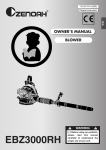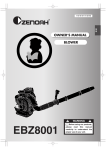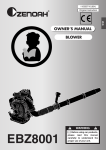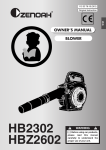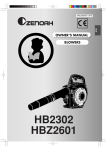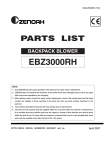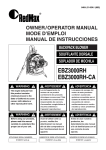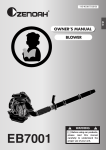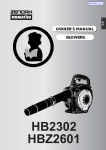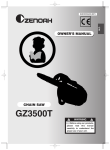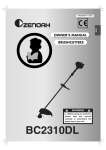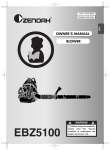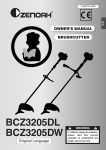Download Zenoah EBZ3000RH Owner`s manual
Transcript
EBZ3000RH 848L2693A0 (902) G B OWNER’S MANUAL BACKPACK BLOWER EBZ3000RH GB-1 EBZ3000RH EC DECLARATION OF COMFORMITY We, Husqvarna Zenoah Co., Ltd. 1-9, Minamidai, Kawagoe, Saitama, Japan declare in sole responsibility that the following products referred to in this declaration conform with DIRECTIVE 89/336/EEC, 98/37/EC 2000/14/EC Internal control production. The products referred to are: DESIGNATION : BLOWER MODELS : EBZ3000RH SERIAL NUMBERS : 70400001 and up Thecompany named above will keep on file the following technical documentation for any inspection purpose. • Operation instructions • Plans and Drawings • Description of measures designed to ensure conformity • Other technical documentation :Specification sheet Inspection standard Saitama, Japan 1st December 2008 Isamu NAKAZATO General Manager, Quality Assurance Department EXPLANATION OF SYMBOLS AND SAFETY WARNINGS WARNING!!! RISK OF DAMAGING HEARING Wear head, eye and ear protection. MODEL EBZ3000RH 29.5 cm3 SOUND LEVEL ISO 11094 LwA guaranteed measured 99.6 dB(A) 100 dB(A) VIBRATION LEVEL ON HANDLE ISO 22867 ahv,eq A(8) 2.4 m/s2 1.45 m/s2 APPROVAL NUMBER OF CE EXHAUST EMISSION REGULATION (2002/88/EC) e13*97/68SH2G3*2002/88*0098*02 GB-2 EBZ3000RH SAFETY FIRST Instructions contained in warnings within this manual marked with a symbol concern critical points which must be taken into consideration to prevent possible serious bodily injury, and for this reason you are requested to read all such instructions carefully and follow them without fail. WARNINGS IN THE MANUAL WARNING This mark indicates instructions, which must be followed in order to prevent accidents, which could lead to serious bodily injury or death. IMPORTANT This mark indicates instructions, which must be followed, or it leads to mechanical failure, breakdown, or damage. Contents 1. 2. 3. 4. 5. 6. 7. 8. 9. 10. 11. 12. Parts location .................................................. 3 Specifications ................................................. 4 Warning labels on the machine ...................... 4 Symbols on the machine ................................ 4 For safe operation ........................................... 5 Set up ............................................................. 8 Fuel ................................................................. 9 Operation ...................................................... 10 Maintenance ................................................. 11 Storage ......................................................... 13 Disposal ........................................................ 13 Troubleshooting guide .................................. 14 NOTE This mark indicates hints or directions useful in the use of the product. 1. Parts location 1. 2. 3. 4. 5. 6. 7. 8. 9. 10. 11. 12. 13. 14. Frame Shoulder Strap Spark Plug Cap Throttle Lever Net Choke Lever Air Cleaner Volute Case “CAUTION” Label Elbow Fuel Tank Recoil Starter Ignition Switch Engine Cover GB-3 G B EBZ3000RH 2. Specification Model Dimensions (LxWxH) mm Dry weight (w/o Pipe) kg Fuel tank capacity liter Engine Type Displacement cm3 Air Filter Carburetor Ignition system Spark plug Muffler Operating Engine Speed rpm Fuel Consumption liter/h Average Air Volume (w/std Pipe)cu.m/min. Maximum Air Volume (w/o Pipe) cu.m/min. Max. Air Velocity m/sec. EBZ3000RH 313 x 394 x 420 6.2 1.08 Air cooled 2-cycle gasoline engine 29.5 Dry Urethane Rotary C.D.I. NGK CMR7H (Noise-proof) Spark arrester equipped 3000 to 6500 0.58 10.7 13.1 57.4 Specifications are subject to change without notice. 3. Warning labels on the machine 4. Symbols on the machine For safe operation and maintenance, symbols are carved in relief on the machine. According to these indications, please be careful not to make a mistake. Read owner’s manual before operating this machine. The port to refuel the “MIX GASOLINE” Position: FUEL TANK CAP Wear head, eye and ear protection. The direction to close the choke Position: AIR CLEANER BODY Warning / Attention Keep all children, bystanders and helpers 15 meters away from the machine. If warning label peels off or becomes soiled and impossible to read, you should contact the dealer from which you purchased the product to order new labels and affix them in the required location(s). Never modify your machine. We won’t warrant the machine, if you use the remodeled blower or if you don’t observe the proper usage written in the manual. GB-4 The direction to open the choke Position: AIR CLEANER BODY EBZ3000RH 5. For safe operation 1. Read this manual carefully until you completely understand and follow all safety and operating instructions. 2. Keep this manual handy so that you may refer to it later whenever any questions arise. Also note, if you have any questions which cannot be answered herein, contact the dealer from whom you purchased the product. 3. Always be sure to include this manual when selling, lending, or otherwise transferring the ownership of this product. 4. Do not lend or rent your machine without the owner's manual. 5. Be sure that anyone using your unit understands the infomation contained in this manual. 6. Never let a child under 13 years old use the machine. WORKING CONDITION 1. Refrain from operating the blower if you are tired, ill, or upset, or if you are under the influence of alcohol, drugs or medication. 2. To reduce the risk of hearing loss associated with sound level(s), hearing protection is required. 3. To reduce the risk of injury associated with thrown objects, always wear eye protection and foot protection. Eye protection should meet the requirements of ANSI Z87.1. 4. To reduce the risk of injury associated with the inhalation of dust, use a face filter mask in dusty conditions. 5. Wear sturdy rubber-soled shoes or shoes with some other form of anti-slip protection to help protect you against falling. 6. To reduce the risk of injury associated with objects being drawn into rotating parts, do not wear loose clothing, scarves, neck chains, hair longer than shoulder length, or other loose material. 7. Prolonged use of a blower, exposing the operator to vibrations and cold may produce whitefinger disease (Raynaud’s phenomenon), which symptoms are tingling and burning sensations followed by loss of color and numbness in the fingers. All factors which contribute to whitefinger disease are not known, but cold weather, smoking diseases or physical conditions as well as long periods of exposure to vibration are mentioned as factors. In order to reduce the risk of whitefinger disease, the following precautions are strongly recommended; a) Keep your body warm. Never use blower during rains. b) Wear thick anti-vibration gloves. c) Take more than 5 minutes of break in warm place frequently. d) Maintain a firm grip at all times, but do not squeeze the handles with constant, excessive pressures. e) If you feel discomfort, redness and swelling of your fingers or any other part of your body, see a doctor before getting worse. 8. The ignition system of your unit produces an electromagnetic field of a very low intensity. This field may interfere with some pacemakers. To reduce the risk of serious or fatal injury, persons with pacemaker should consult their physician and the pacemaker manufacturer before operating this tool. WORKING CIRCUMSTANCE 1. To reduce the risk of injury associated with exhaust fume inhalation, do not operate in unventilated area. The exhaust gases contain harmful carbon monoxide. 2. Avoid using the blower where stable footing and balance are not assured. AVOID NOISE PROBLEM IMPORTANT Check and follow the local regulations as to sound level and hours of operations for blower. GB-5 G B EBZ3000RH 5. For safe operation 1. Operate power equipment only at reasonable hours-not early in the morning or late at night when people might be disturbed. Comply with times listed in local ordinances. 2. To reduce sound levels, limit the number of pieces of equipment used at any one time. 3. Operate power blowers at the lowest possible throttle speed to do the job. 4. Check your equipment before operation, especially the muffler, air intakes and air filters. WORKING PLAN • When planning your work schedule, allow plenty of time to rest. Limit the amount of time over which the product is to be used continuously to somewhere around 30 ~ 40 minutes per session, and take 10 ~ 20 minutes of rest between work sessions. Also try to keep the total amount of work performed in a single day under 2 hours or less. FUEL WARNING To reduce the risk of fire and burn injury: a) Handle fuel with care. It is highly flammable. b) Do not smoke while handing fuel. c) Do not refuel a hot engine. d) Do not refuel a running engine. e) Avoid spilling fuel or oil. Always wipe unit dry before using. f) Move at least 10 ft. (3 meters) away from the fueling point before starting engine. g) Always store gasoline in a container approved for flammable liquids. h) Make sure the unit is properly assembled and in good operating condition. GB-6 BEFORE STARTING THE ENGINE • Each time before starting the engine, inspect the entire unit to see if every part is in good order and is securely tightened in place. If any damage is found in the fuel line, the exhaust line, or the ignition wiring, do not use the blower until it has been repaired. IMPORTANT • Before starting operation, always make sure to check if any obstacles are left inside the volute case and net. The obstacles may cause damage on fan and volute case and serious injury. WARNING • Check to see if the shock-absorbing rubber and spring mount has become cracked or otherwise damaged. Note that failing to replace this rubber mount when it has become cracked or damaged may cause the engine to come loose from its frame during use, thus resulting in possible serious bodily injury. • If cracked, be sure to replace without delay. WARNING • To reduce the risk of injury associated with contacting rotating parts, stop the engine before installing or removing attachments. Do not operate without net in place. Always disconnect the spark plug before performing maintenance or accessing movable parts. USING THE PRODUCT 1. Check the work area that the blower will be used in and remove or cover all valuables that may be damaged by the air blast or thrown debris. 2. To reduce the risk of injury associated with thrown objects. a) Watch out for children, pets, open windows or freshly washed cars, and blow debris safely away. b) Use the full blower nozzle extension so the air stream can work close to the ground. c) Do not allow bystanders in work area. d) Do not point the blower tube in the direction of people or pets. e) Always check to be sure that no debris has been blown onto someone else’s property. EBZ3000RH 5. For safe operation f) Pay attention to the direction of the wind, do not work against the wind. g) Never point a blower tube toward an open flame to avoid the possibility of igniting the unit, causing injury to yourself or damage to surroundings. 3. To minimize blowing time. a) Use rakes and brooms to loosen debris before blowing. b) In dusty conditions, slightly dampen surfaces or use mister attachment when water is available. c) Conserve water by using power blowers instead of hoses for many lawn and garden applications, including areas such as gutters, screens, patios, grills, porches and gardens. 4. Never to touch the spark plug or plug cord while the engine is in operation. Doing so may result in being subjected to an electrical shock. 5. Never to touch the muffler, spark plug, or other metallic parts of the engine or engine cover while the engine is in operation or immediately after shutting down the engine. These metallic parts and engine cover reach high temperatures during operation and doing so could result in serious burns. 6. After using blowers and other equipment, CLEAN UP! Dispose of debris in trash receptacles. MAINTENANCE 1. In order to maintain your product in proper working order, perform the maintenance and checking operations described in the manual at regular intervals. 2. Always be sure to turn off the engine and disconnect the spark plug before performing any maintenance or checking procedures. 3. Examine the blower at intervals for loose fasteners and rusted or damaged parts. Use special care around the fuel line, the muffler, and the ignition wiring. 4. All engine service except for those described in this manual should be performed by competent service personnel. Improper service to the blower fan and muffler could cause a hazardous failure. 5. When replacing the any other part, or any lubricant, always be sure to use only ZENOAH products or products which have been certified by ZENOAH for use with the ZENOAH product. 6. In the event that any part must be replaced or any maintenance or repair work not described in this manual must be performed, please contact a representative from the store nearest ZENOAH authorized servicing dealer for assistance. 7. Do not use any accessory or attachment other than those bearing the ZENOAH mark and recommended for the unit. 8. Under no circumstances should you ever take apart the product or alter it in any way. Doing so might result in the product becoming damaged during operation or the product becoming unable to operate properly. TRANSPORTATION • Drain the fuel from the fuel tank before transporting or storing the blower. • Secure the unit carefully to prevent movement when it is transported. • A unit that receives a strong shock during transport and unloading may malfunction. STORAGE • When storing the blower, choose a space indoors free from moisture and out of the reach of children. WARNING The metallic parts and engine cover reach high temperatures immediately after stopping the engine. GB-7 G B EBZ3000RH 6. Set up BLOWER TUBES 1. Connect the blower and swivel joint with flexible hose. Clamp both ends of the flexible hose securely with the hardware supplied with the unit. 2. Align the protrusion and the groove provided on the tube ends and twist the tube until connection is locked up. NOTE A light lubricant may be used to ease assembly of flexible pipe to blower elbow. THROTTLE LEVER • Set up the clamp to the swivel and tighten the screw on the clamp. (1) Clamp (2) Swivel (3) Screw THROTTLE CABLE 1. First, lightly tighten the hose in the middle of it by putting the band through the hole (a). 2. Next, lightly tighten the cable by putting the band through the hole (b). (1) Hose (2) Band (3) Cable GB-8 EBZ3000RH 7. Fuel ■ FUEL • Gasoline is very flammable. Avoid smoking or bringing any flame or sparks near fuel. Make sure to stop the engine and allow it cool before refueling the unit. Select outdoor bare ground for fueling and move at least 3 m (10 ft) away from the fueling point before starting the engine. • The Zenoah engines are lubricated by oil specially formulated for air-cooled 2-cycle gasoline engine use. If Zenoah oil is not available, use an anti-oxidant added quality oil expressly labeled for air-cooled 2-cycle engine use (JASO FC GRADE OIL or ISO EGC GRADE). • Do not use BIA or TCW (2-stroke water-cooling type) mixed oil. ■ RECOMMENDED MIXING RATIO GASOLINE 50 : OIL 1 <when using ZENOAH genuine oil> • Exhaust emission are controlled by the fundamental engine parameters and components (eq., carburation, ignition timing and port timing) without addition of any major hardware or the introduction of an inert material during combustion. • These engines are certified to operate on unleaded gasoline. • Make sure to use gasoline with a minimum octane number of 89RON (USA/Canada: 87AL). • If you use a gasoline of a lower octane value than prescribed, there is a danger that the engine temperature may rise and an engine problem such as piston seizing may consequently occur. • Unleaded gasoline is recommended to reduce the contamination of the air for the sake of your health and the environment. • Poor quality gasolines or oils may damage sealing rings, fuel lines or fuel tank of the engine. ■ HOW TO MIX FUEL IMPORTANT • Pay attention to agitation. 1. Measure out the quantities of gasoline and oil to be mixed. 2. Put some of the gasoline into a clean, approved fuel container. 3. Pour in all of the oil and agitate well. 4. Pour in the rest of gasoline and agitate again for at least one minute. As some oils may be difficult to agitate depending on oil ingredients, sufficient agitation is necessary for the engine to last long. Be careful that, if the agitation is insufficient, there is an increased danger of early piston seizing due to abnormally lean mixture. 5. Indicate the contents on outside of container for easy identification. To avoid mixing up with gasoline or other containers. ■ FUELING THE UNIT 1. Untwist and remove the fuel cap. Rest the cap on a dustless place. 2. Put fuel into the fuel tank to 80% of the full capacity. 3. Fasten the fuel cap securely and wipe up any fuel spillage around the unit. 1. Select bare ground for fueling. 2. Move at least 10 feet (3 meters) away from the fueling point before starting the engine. 3. Stop the engine before refueling the unit. At that time, be sure to sufficiently agitate the mixed gasoline in the container. 4. Do not smoke or place hot object near fuel. ■ FOR YOUR ENGINE LIFE, AVOID: 1. FUEL WITH NO OIL (RAW GASOLINE) – It will cause severe damage to the internal engine parts very quickly. 2. GASOHOL – It can cause deterioration of rubber and/ or plastic parts and disruption of engine lubrication. 3. OIL FOR 4-CYCLE ENGINE USE – It can cause spark plug fouling, exhaust port blocking, or piston ring sticking. 4. Mixed fuels which have been left unused for a period of one month or more may clog the carburetor and result in the engine failing to operate properly. 5. In the case of storing the product for a long period of time, clean the fuel tank after rendering it empty. Next, activate the engine and empty the carburetor of the composite fuel. 6. In the case of scrapping the used mixed oil container, scrap it only at an authorized repository site. • As for details of quality assurance, read the description in the section Limited Warranty carefully. Moreover, normal wear and change in product with no functional influence are not covered by the warranty. Also, be careful that, if the usage in the instruction manual is not observed as to the mixed gasoline, etc. described therein, it may not be covered by the warranty. GB-9 G B EBZ3000RH 8. Operation STARTING ENGINE IMPORTANT • Avoid operating the blower with the flexible tube and swivel joint disconnected. That will reduce the cooling air and the engine could be damaged by overheating. 1. Push the primer bulb until fuel flows out in the clear tube. (1)Primer Bulb exhaust port. • Never touch the muffler, spark plug, other metallic parts of the engine or engine cover while the engine is in operation or immediately after shutting down the engine. These metallic parts and engine cover reach high temperatures during operation and doing so could result in serious burns. 6. Once the engine is running, gradually open the choke if it was set closed, and let the engine run at idle speed for a minute to warm it up. NOTE When the engine fails to start after several attempts due to overchoking, open the choke and repeat pulling the rope. 2. When the engine is cool, close the choke. (1)Choke Lever (2)CLOSE (3)OPEN 3. Set the ignition switch to the start position. (3) (1)Full Throttle (2)Idling (3)Ignition Switch (1) ADJUSTING IDLE SPEED • The idling speed is set for 3000 rpm at the factory. If it is necessary to adjust the idle speed, use the adjustment screw on the top side of carburetor. (1) (1)Idling Adjustment Screw STOPPING ENGINE • Move the throttle lever to the idling position and set the ignition switch to the stop position. (2) (1)Ignition Switch (1) 4. Set the throttle lever in idling position. 5. To start, hold the top of the blower firmly with your left hand. Pull the starter knob slowly until you feel it engage and then give it a vigorous strong pull. NOTE If the engine won’t stop when setting the ignition switch to the stop position, close the choke lever and stop the engine. In this case, please repair the machine at your nealest servicing dealer. IMPORTANT • Avoid pulling the starter rope out to its full extent and allowing the starter rope to snap back. This will prevent premature damage to the starter. • Do not let a person stand near the blower or the GB-10 (1)Choke Lever (2)CLOSE (3)OPEN EBZ3000RH 9. Maintenance Maintenance, replacement, or repair of the emission control device and systems may be performed by any non-road engine repair establishment or individual. System / Compronent Procedure Air Filter Fuel Leaks Fuel Filter Fuel Line Spark Plug Muffler Muffler Spark Arrester Cooling Systrem Screws / Nuts / Bolts Cylinder Exhaust Port Inspect / Clean Inspect / Replace Inspect / Replace Inspect / Clean Inspect / Clean Inspect / Clean Inspect / Clean Inspect / Clean Tighten Inspect / Clean Daily or Before use ✔ ✔ ✔ Every 25 hours after ✔ Every Every 50 hours 100 hours after after ✔ ✔ ✔ ✔ ✔ ✔ ✔ WARNING Make sure that the engine has stopped and is cool before performing any service to the blower. Contact with rotating blower fan or hot muffler may result in a personal injury. AIR CLEANER • Check the air cleaner every 25 hours of use or more frequently if used under dusty conditions. A clogged air filter may increase fuel consumption while cutting down the engine power. Never operate the blower without the air filter or with a deformed filter element because unfiltered dusty air may quickly ruin the engine. (1) Element (2) Screen FUEL FILTER • A clogged fuel filter may cause poor acceleration of the engine. Check periodically to see if the filter is clogged with dirt. The filter can be taken out of the fueling port using a small wire hook. Disconnect the filter assembly from the fuel pipe and unhook the retainer to disassemble it. Clean the components with gasoline. CLEANING AIR FILTER: 1. Remove the air cleaner cover. 2. Use neutral detergent and warm water to clean the filter element. After cleaning, air dry the element completely. 3. Reinstall the filter. Never forget to attach the screen. If the screen is not attached, the cleaner will not seal properly and the dusts come into the cylinder. (1) Screen (3) Holder (2) Element (4) Retainer GB-11 G B EBZ3000RH 9. Maintenance SPARK PLUG • The spark plug may gather carbon deposits on its firing end with reasonable use. Remove and inspect the spark plug every 25 hours and clean the electrodes as necessary with a wire brush. The spark gap should be adjusted to .025 in (0.6~0.7mm). (1) (2) (3) (4) • Plug manufacturers recommend replacing the plug twice a year to avoid unexpected plug failure in a job. REPLACEMENT PLUG IS NGK CMR7H. IMPORTANT • Note that using any spark plugs other than those designated may result in the engine failing to operate properly or in the engine becoming overheated and damaged. • To install the spark plug, first turn the plug until it is finger tight, then tighten it a quarter turn more with a socket wrench. MUFFLER WARNING • Inspect periodically, the muffler for loose fasteners, any damage or corrosion. If any sign of exhaust leakage is found, do not use the blower and have it repaired immediately. • Note that failing to do so may result in the engine catching on fire. IMPORTANT • Before starting operation, always make sure to check if the muffler is properly held by two bolts. (Fastening Torque : 7 to 11 N·m) • Also make sure that the spark arrester and the diffuser are properly attached with two bolts. (Fastening Torque : 2 to 3 N·m) • Even if one of four bolts is loose, it may result in engine catching on fire. GB-12 Bolt Bolt Spark Arrester Diffuser SPARK ARRESTER • The muffler is equipped with a spark arrester to prevent red hot carbon from flying out of the exhaust outlet. Periodically inspect and clean as necessary with a wire brush. In the State of California it is required by law (Section 4442 of the California Pulic Resources Code) to equip a spark arrester when a gas powered tool is used in any forest covered, bush covered, or grass covered unimproved land. PROCEDURES TO BE PERFORMED AFTER EVERY 100 HOURS OF USE 1. Remove the muffler, insert a screwdriver into the vent, and wipe away any carbon buildup. Wipe away any carbon buildup on the muffler exhaust vent and cylinder exhaust port at the same time. 2. Tighten all screws, bolts, and fittings. EBZ3000RH 9. Maintenance AIR INLET NET IMPORTANT • Blowing air is taken in from the air inlet net. When air flow has dropped down during operation, stop the engine and inspect the air inlet net for blocking by obstacles. • Note that failure to remove any such obstacles may result in the engine becoming overheated and damaged. (1)Net SHOULDER STRAP • If the shoulder strap is damaged it may break during use, thus causing the product to fall and resulting in personal injury. Follow the instructions below to replace the shoulder strap with new one. 1. Hook the upper part of the shoulder strap at the notch on the top of the frame and pass it through the buckle as shown in the figure, then secure it firmly. 2. Put the hook at the lower part of the shoulder strap in the strap installing location at the bottom of the frame. (1) (2) (3) (4) WARNING Never use the blower without the net of the blower. Before each use, check that the net is attached in place and is free from any damage. (1) Buckle (3) Hook (2) Frame (4) D-ring IGNITION COIL AIR GAP INSPECTION • If the gap is out of standard or when installing the coil or rotor, adjust the air gap between the ignition coil and the iron core of the rotor. Air Gap: 0.40mm (0.35 ~ 0.45mm) 0.016" (0.014 ~ 0.017") 10. Storage BEFORE STORING THE BLOWER: 1. Drain a fuel tank and push the primer bulb until it becomes empty of fuel. 2. Remove the spark plug and drop a spoonful of 2-cycle oil into the cylider. Crank the engine several times and install the spark plug. 3. Store unit in a dry, dust free place, out of the reach of children. 11. Disposal When disposing your machine, fuel or oil for the machine, be sure to allow your local regulations. (1) Rotor (2) Ignition coil GB-13 G B EBZ3000RH 12. Troubleshooting guide Case 1. Starting failure CHECK fuel tank fuel filter carburetor adjustment screw sparking (no spark) spark plug → → → → → → PROBABLE CAUSES incorrect fuel fuel filter is clogged out of normal range spark plug is fouled/wet plug gap is incorrect disconnected Case 2. Engine starts but does not keep running/hard re-starting CHECK PROBABLE CAUSES fuel tank → incorrect fuel or staled fuel carburetor adjustment screw → out of normal range muffler, cylinder (exhaust port) → carbon is built-up air cleaner → clogged with dust cylinder fin, fan cover → clogged with dust → → → → → → ACTION drain it and use correct fuel clean adjust to normal range clean/dry correct (GAP: 0.6 ~ 0.7 mm) retighten → → → → → ACTION drain it and use correct fuel adjust to normal range wipe away wash clean When your unit seems to need further service, please consult with our ZENOAH service shop in your area. Limited warranty Should any failure occur on the product under normal operating conditions within the applicable warranty period, the failed part will be replaced or repaired free of charge by a ZENOAH authorized dealer. WARRANTY PERIOD: 1 year (6 months if used professionally, and 30 days if used for rental purpose) from the date of initial purchase. THE PURCHASER SHALL BEAR COSTS OF TRANSPORTING THE UNIT TO AND FROM THE ZENOAH DEALER. THE PURCHASER SHALL NOT BE CHARGED FOR DIAGNOSTIC LABOR WHICH LEADS TO THE DETERMINATION THAT A WARRANTED PART IS DEFECTIVE, IF THE DIAGNOSTIC WORK IS PERFORMED AT THE ZENOAH DEALER. THE PURCHASER OR OWNER IS RESPONSIBLE FOR THE PERFORMANCE OF THE REQUIRED MAINTENANCE AS DEFINED BY THE MANUFACTURER IN THE OWNER/OPERATOR MANUAL. ANY WARRANTED PART WHICH IS NOT SCHEDULED FOR REPLACEMENT AS REQUIRED MAINTENANCE, OR WHICH IS SCHEDULED ONLY FOR REGULAR INSPECTION TO THE EFFECT OF REPAIR OR “REPLACE AS NECESSARY” SHALL BE WARRANTED FOR THE WARRANTY PERIOD. ANY WARRANTED PART WHICH IS SCHEDULED FOR REPLACEMENT AS REQUIRED MAINTENANCE SHALL BE WARRANTED FOR THE PERIOD OF TIME UP TO THE FIRST SCHEDULED REPLACEMENT POINT FOR THE PART. ANY REPLACEMENT PART THAT IS EQUIVALENT IN PERFORMANCE AND DULABILITY MAY BE USED IN NON- GB-14 WARRANTY MAINTENANCE OR REPAIRS, AND SHALL NOT REDUCE THE WARRANTY OBLIGATION OF THE COMPANY. THE COMPANY IS LIABLE FOR DAMAGES TO OTHER ENGINE COMPONENTS CAUSED BY THE FAILURE OF A WARRANTED PART STILL UNDER WARRANTY. THE WARRANTY DOES NOT APPLY TO THOSE UNITS WHICH HAVE BEEN DAMAGED BY NEGLIGENCE OF INSTRUCTION LISTED IN THE OWNER/OPERATOR MANUAL FOR PROPER USE AND MAINTENANCE OF THE UNITS ACCIDENT MISHANDLING, ALTERATION, ABUSE, IMPROPER LUBRICATION, USE OF ANY PARTS OR ACCESSORIES OTHER THAN THOSE SPECIFIED BY THE COMPANY, OR OTHER CAUSES BEYOND THE COMPANY’S CONTROL. THIS WARRANTY DOES NOT COVER THOSE PARTS REPLACED BY NORMAL WEAR OR HARMLESS CHANGES IN THEIR APPEARANCE. THERE ARE NO OTHER EXPRESS WARRANTIES. IMPLIED WARRANTIES INCLUDING THOSE OF MERCHANTABILITY AND FITNESS FOR A PARTICULAR PURPOSE ARE LIMITED TO TWO (2) YEARS OF HOME USE [ONE (1) YEAR FOR ANY OTHER USE] FROM THE ORIGINAL DELIVERY DATE. LIABILITIES FOR INCIDENTAL OR CONSEQUENTIAL DAMAGE UNDER ANY AND ALL WARRANTIES ARE EXCLUDED. IF YOU NEED TO OBTAIN MORE INFORMATION, PLEASE CALL YOUR NEAREST SERVICE CENTER, OR CHECK PLEASE ZENOAH WEB SITE http://www.zenoah.net














